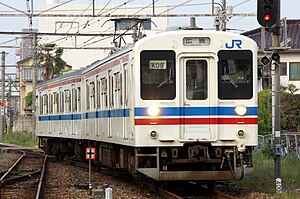105 series
| 105 series | |
|---|---|

Set K09 on a Kabe Line service in May 2012
|
|
| In service | 1981–Present |
| Number built | 125 vehicles |
| Number in service | 112 vehicles (56 sets) |
| Formation | 2/4 cars per trainset |
| Operator(s) |
JNR (1981-1987) JR East (1987-1998) JR-West (1987-Present) |
| Depot(s) | Hineno, Okayama, Shimonoseki, Hiroshima |
| Line(s) served |
Sakurai Line Wakayama Line Kisei Main Line Sanyō Main Line Fukuen Line Ube Line Onoda Line |
| Specifications | |
| Car body construction | Steel |
| Car length | 20,000 mm (65 ft 7 in) |
| Width | 2,800 mm (9 ft 2 in) |
| Doors | 3/4 pairs per side |
| Maximum speed | 100 km/h (60 mph) |
| Traction system | Resistor control |
| Power output | 440 kW per car with motors |
| Electric system(s) | 1,500 V DC |
| Current collection method | Overhead catenary |
| Braking system(s) | Dynamic brake, Electro-pneumatic brake, Hand brake |
| Track gauge | 1,067 mm (3 ft 6 in) |
The 105 series (105系 Hyaku-go-kei?) is a DC electric multiple unit (EMU) train type formerly operated by Japanese National Railways (JNR), and currently operated on local services by West Japan Railway Company (JR-West) in Japan since 1981. They were also formerly operated by East Japan Railway Company (JR East).
The 105 series was introduced in 1981 to replace early EMU types operating on the Fukuen Line, Ube Line, and Onoda Line in western Japan. The rural nature and low line speed of these lines meant that 101 series or 103 series commuter EMUs would have been unnecessarily over-powered with their high proportion of motored cars, and so the 105 series was designed with one motored car per two cars.
The first sets introduced were 105-0 series 2-car sets which were newly built in 1981 with three pairs of doors per side. 105-500 series 2-car sets were later introduced, converted from former 103 series EMU cars, with four pairs of doors per side.
As of 1 April 2012, 56 2-car sets are operated by JR-West, based at Hineno, Okayama, Shimonoseki, and Hiroshima depots.
60 105-0 series vehicles were built in 1981, formed as 2-car sets for use on the Onoda Line and Ube Line, and 4-car sets for use on the Fukuen Line. Initially, these sets were not equipped with air-conditioning.
These were originally formed as follows.
The KuMoHa and MoHa cars were each equipped with one lozenge-type pantograph.
...
Wikipedia
